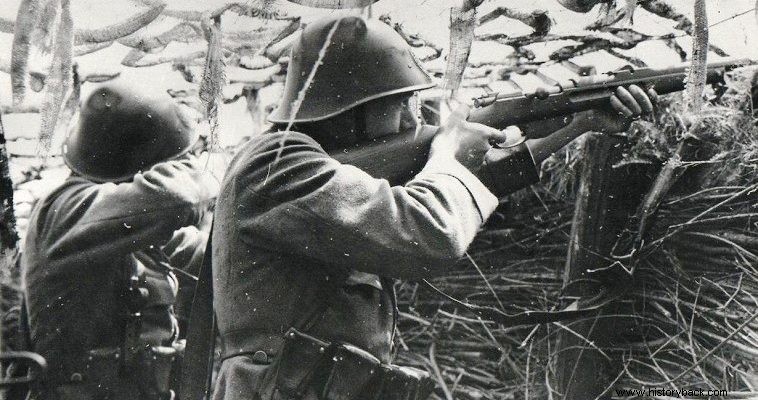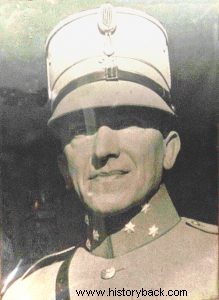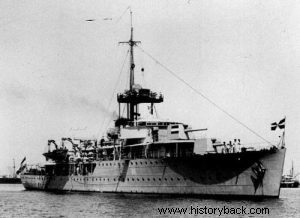
Dutch territory is largely below sea level. In order for the Dutch to be able to live on their land, they have, from time immemorial, built dams and dykes that hold back the water. Such an embankment is also the one in Afflusdik (final embankment). With a length of 32 km, the dyke-dam holds back the sea and starts from the coast of Friesland, where the Dutch had built the Kornverdersand fort.
On the embankment there is a road that connects the north-eastern Netherlands with Amsterdam. This very corridor was the target of the Germans. On May 10, strong German forces invaded the Netherlands. Among them was the 1st Cavalry Division under General Kurt Feld . The Germans having inflicted serious blows on the small Dutch army, also using airborne forces, judged that a rapid advance towards Amsterdam was feasible.
So Feld decided to move quickly. But Kornverdersand was an obstacle. The "fortress" in question was a line of 17 machine guns and artillery of which only 3 were relatively large. The garrison consisted of 225 men under the captain Christian Francis Ioannis Boers and had 21 7.92 mm machine guns. and four 50mm guns. The three largest fortifications were strongly built and protected by reinforced concrete walls 3 m thick and resistant to 210 mm cannon fire.
At the start of the German attack on Holland, Boers had sent two of his platoons (70 men) in front of the fortifications as a guard. However, these two platoons were hit by German aircraft and forced to withdraw to the main resistance site. One soldier and two Dutch civilians were killed by the German bombing.
However, the Germans did not continue the attack immediately. Feld decided to wait for stronger air support, which he received on 12 May. On the evening of May 11, however, Feld sent out a patrol to see if the Dutch were holding the line of fortifications. Suddenly the Germans came under fire and two of them were killed. The Dutch would fight.
German attacks
On the morning of May 12, 62 German aircraft attacked the fortifications. Immediately afterwards the German howitzers and 88 mm guns got to work. After the heavy bombardment 500 German soldiers marched against the Dutch but were pinned down. But Feld did not know that on the night of 12-13 May the Boers had been reinforced with 3 anti-aircraft guns of 20 mm. and four anti-aircraft machine guns.
So when the Dutch began firing on the German planes, on the morning of the 13th when the Germans attacked again, Feld was more surprised than the pilots. Luftwaffe aircraft carried out five attacks but four of them were shot down. A heavy but ineffective bombardment by the German artillery followed for an hour, and immediately afterwards a German raiding party attacked.
The Dutch let them get to 800m before opening fire with their machine guns pinning their opponents in a ditch in front of the fortifications. No German could raise his head... When night fell Boers ordered his men to fire flares at regular intervals so that the Germans could not make a surprise attack.
On the morning of May 14, the Germans launched a new bombardment with their artillery. But Boers had an answer. In the evening he had called the HMLMS gunboat "John Maurice of Nassau" for reinforcements. The Dutch vessel had 3 150 mm guns. with which he bombarded the German guns from a distance of 18 km. The Dutch fire directed by telephone was extremely accurate and the German guns fell silent. Feld suffered a second surprise and ordered the attacks to cease.
However, the hitherto undefeated Boers and his men received, the next day, the bitter order. The Dutch forces capitulated, after the Luftwaffe's unnecessary and deadly aerial bombardment of Rotterdam. Boers congratulated his men for fighting heroically and obeyed the order. The battle was over. The Dutch lost only one soldier. The Germans, in their habit of admitting small losses, declared that in the battle they had 5 dead and 25 wounded.
Civilian eyewitnesses, however, spoke of heavy German losses and of "trenches full of dead". The gunboat "John Maurice of Nassau" sank trying to escape to Britain. 17 men of his crew were killed.
Captain Christian Francis Ioannis Boers
The head of the Dutch defense Captain Boers was born in 1889. He was a graduate of the military academy and a truly brave man. After the capitulation Boers immediately joined the resistance , in an organization formed by ex-servicemen. But the Germans managed to erode the organization and most of its members were arrested in the spring and summer of 1941.
Boers ended up in the Sachsenhausen death camp where, after a "trial", he was executed. His men described him as a "born leader" and an excellent professional officer. After the liberation of the Netherlands, his homeland awarded him posthumously. Today there is a monument to him on the battlefield, while in 2005 the viaduct there was named after him. Boers' son and grandson were present at the related ceremony.

Captain Boers.

The Dutch gunboat "John Maurice of Nassau".
PANTELIS D. KARYKAS
